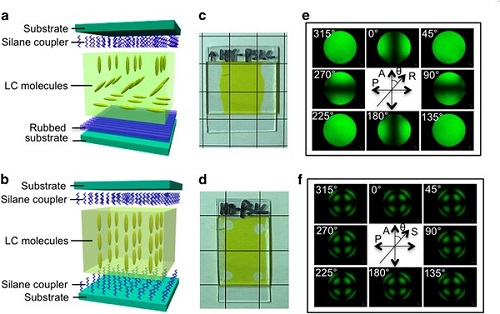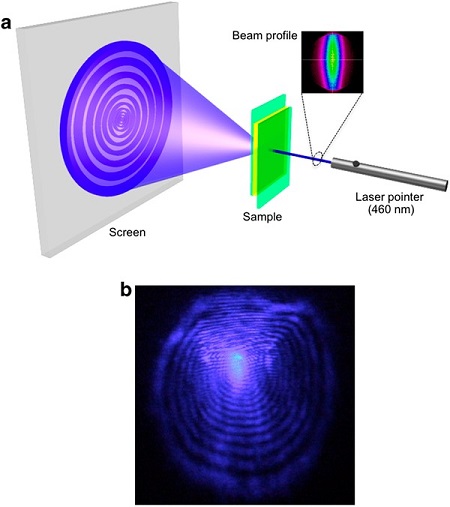Latest Research
- 2015.07.08
Laser pointer induces nonlinear optical effect in hybrid-aligned dye-doped liquid crystals
Nonlinear optics (NLO) describes the behaviour of light in nonlinear media, for which the dielectric polarization responds to the incoming light field in a nonlinear manner1, 2. NLO has immense potential in applications dependent on nonlinear processes, for instance, frequency conversion3, 4, multiple-photon absorption5, 6, and self-phase modulation7, 8. However, the generation of such optical nonlinearities typically requires very high light intensities and thus costly lasers. Crystals9, polymers3, 10, and liquid crystals (LCs)11 exhibiting high optical nonlinearity have been extensively studied with the aim of creating NLO effects using inexpensive, low-power lasers. The intensity-dependent refractive index, one of the useful NLO effects, evokes self-focusing, self-phase modulation, phase conjugation, and the generation of optical solitons. It thereby possesses great potential for use in a range of photonic applications, such as optical switching, data storage, and light-beam modulation12, 13, 14, 15.
Here, we report that the light intensity needed to induce the self-focusing effect can be reduced to levels accessible with a common 1 mW handheld laser pointer in polymer-stabilized TR5-doped LC (PSLC)16. The key to this achievement is the use of hybrid molecular alignment instead of the commonly used homeotropic or planar LC alignment. Hybrid alignment refers to homeotropic (out-of-plane) alignment at one substrate of the LC cell, while homogeneous (in-plane) alignment occurs at the other substrate, as illustrated in Fig. 117. Hybrid alignment has been investigated mostly from a theoretical perspective for issues such as LC molecular alignment18 and light propagation behaviour. We chose to use hybrid LC alignment because of the unique properties of hybrid-aligned cells. These include optical transparency, a bistable surface, and opposed surface anchoring, which might enhance reorientational optical nonlinearities in LC systems. The NLO response of the hybrid-aligned TR5-doped PSLC film was compared to homeotropic-aligned film with the same composition.

Figure 1. (a) Sketch of the geometry of a hybrid-aligned cell.
(b) Sketch of the geometry of a homeotropic-aligned cell.
(c) Photograph of a hybrid-aligned cell. (d) Photograph of a homeotropic-aligned cell. (e) Polarized optical micrograph of a hybrid-aligned cell on a rotatable stage. (f) Polarized optical micrograph of a homeotropic-aligned cell on a rotatable stage. Optically transparent film with hybrid alignment is confirmed from photograph and conoscopic images with a polarized optical microscope. 16
The threshold intensity of the hybrid-aligned PSLC cell to induce molecular reorientation based on nonlinear optical effect was at its lowest (0.4 W/cm2) in the homeotropic-0 arrangement, that is, when light having polarization parallel to the rubbing direction was incident on the sample from the homeotropic side. The threshold was then compared to that of the homeotropic-aligned PSLC sample with the same composition. The threshold intensity was markedly reduced in the hybrid-aligned cell by a factor of 8.5 compared with that of homeotropic-aligned PSLC (3.4 W/cm2). To the best of our knowledge, this is the lowest value obtained for the order-to-order type of self-focusing effect (from the original molecular alignment to the molecular director parallel to light polarization). Hence, the laser power required for nonlinear optical molecular reorientation could be in the sub-100 μW range and would be accessible with common low-power handheld laser pointers. As shown in Fig. 2, the diffraction ring patterns due to self-focusing and self-phase modulation immediately appeared in the hybrid-aligned cell merely by turning on the laser pointer.

Figure 2. (a) Sketch of the optical setup for the observation of the laser-pointer-driven nonlinear optical effect in a hybrid-aligned cell. (b) Typical laser-pointer-driven ring pattern generated from a hybrid-aligned cell (TR5: 0.03 mol%). A 1 mW commercially available laser pointer drives molecular reorientation, leading to self-focusing and self-phase modulation. 16
In summary, we demonstrated the nonlinear optical effect of hybrid-aligned olighothiophene-doped polymer-stabilized LC film. Self-focusing was enabled by photoinduced molecular reorientation at the lowest light intensity of 400 mW/cm2, which is less by a factor of 8.5 than the intensity needed for homeotropic-aligned LC cells with the same composition. Even a battery-operated laser pointer induced the diffraction ring formation due to molecular reorientation. Furthermore, the film showed incident direction sensitivity, hence acting as a simple nonlinear optical diode. A large-area flexible film of the studied materials can be fabricated by display technology, which enables much wider applications of nonlinear optics.
References
1 Shen, Y. R. The principles of nonlinear optics John Wiley & Sons: New York, 1984).
2 Tabiryan, N. V., Sukhov, A. V. & Zel'dovich, B. Y. The orientational optical nonlinearity of liquid crystals. Mol. Cryst. Liq. Cryst. 136, 1-139 (1986).
3 Dalton, L. R., Sullivan, P. A. & Bale, D. H. Electric field poled organic electro-optic materials: state of the art and future prospects. Chem. Rev. 110, 25-55 (2010).
4 Kumar, R. A. Borate crystals for nonlinear optical and laser applications: a review. J. Chem. 2013, 1-6 (2013).
5 Pawlicki, M., Collins, H. A., Denning, R. G. & Anderson, H. L. Two-photon absorption and design of two-photon dyes. Angew. Chem. Int. Ed. 48, 3244-3266 (2009).
6 Park, S., Yang, D. & Lee, K. Two-photon stereolithography for realizing ultraprecise tree-dimensional nano/microdevices. Laser Photon. Rev. 3, 1-11 (2009).
7 Peccianti, M. & Assanto, G. Nematicons. Phys. Rep. 516, 147-208 (2012).
8 Dudley, J. M., Genty, G. & Coen, S. Supercontinuum generation in photonic crystal fiber. Rev. Mod. Phys. 78, 1135-1184 (2006).
9 Sasaki, T., Mori, Y., Yoshimura, M., Yap, Y. K. & Kamimura, T. Recent development of nonlinear optical borate crystals: key materials for generation of visible and UV light. Mater. Sci. Eng. R. 30, 1-54 (2000).
10 Yesodha, S. K., Pillai, C. K. S. & Tsutsumi, N. Stable polymeric materials for nonlinear optics: a review based on azobenzene systems. Prog. Polym. Sci. 29, 45-74 (2004).
11 Khoo, I. C. Nonlinear optics of liquid crystalline materials. Phys. Rep. 471, 221-267 (2009).
12 Hrozhyk, U. A. et al. Azobenzene liquid crystalline materials for efficient optical switching with pulsed and/or continuous wave laser beams. Opt. Exp. 18, 8697-8704 (2010).
13 Matharu, A. S., Jeeva, S. & Ramanujam, P. S. Liquid crystals for holographic optical data storage. Chem. Soc. Rev. 36, 1868-1880 (2007).
14 Khoo, I. C. et al. Dye-doped photorefractive liquid crystals for dynamic and storage holographic grating formation and spatial light modulation. P. IEEE. 8, 1897-1911 (1999). Sio, L. D., Tabiryan, N., Bunning, T., Kimball, B. R. & Umeton, C. Dynamic photonic materials based on liquid crystals. Prog. Opt. 58, 1-64 (2013).
15 Matsumoto, S., Kawamoto, M. & Mizunoya, K. Field-induced deformation of hybrid-aligned nematic liquid crystals: New multicolor liquid crystal display. J. Appl. Phys. 47, 3842-3845 (1976).
16 Wang, J., Aihara, Y., Kinoshita, M., Mamiya, J., Priimagi, A., Shishido, A. Laser-pointer-induced self-focusing effect in hybrid-aligned dye-doped liquid crystals. Sci. Rep. 5, 9890 (2015).
17 Teixeira, P. I. C., Barmes, F., Anquetil-Deck, C. & Cleaver, D. J. Simulation and theory of hybrid aligned liquid crystal films. Phys. Rev. E. 79, 011709-1-011709-9 (2009).
18 Olivares, J. A., Rodriguez, R. F. & Reyes, J. A. Ray tracing and reflectivity measurements in nematic hybrid cells. Opt. Commun. 221, 223-239 (2003).



